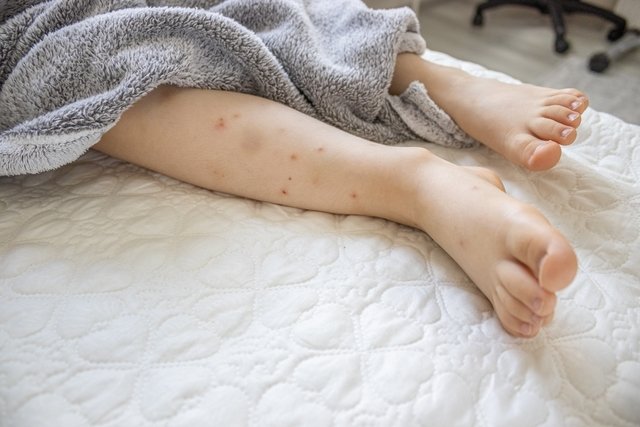Red spots on the legs which emerge without any symptoms are usually not a significant concern. They may be related to insect bites or may even be birth marks.
However, when the spots spread to the rest of the body, and occur with pain, intense itching, fever or headache, it is important to see a doctor. These symptoms may indicate a more serious illness, like lupus.
It is important to monitor your symptoms and to keep an eye on the spots. You should look for spreading of the spots, crusting or skin flaking, and follow up with a doctor if you notice these characteristics.

What causes red spots on the legs?
The most common causes of red spots on the legs include:
1. Insect bites
Red spots that emerge due to bug bites will usually be raised and itchy. This is the most common cause of red spots on the legs. Bites tend to occur on the legs because they are the most accessible area of the body for bugs like ants and mosquitos.
What to do: You should avoid itching your legs, as you may increase the risk for infection in the area. You should use mosquito repellent to prevent new bites. There are gels, creams and ointments available over-the-counter to soothe itching, although some people may need to take anti-histamines to relieve more intense symptoms.
Check out these natural mosquito repellent recipes that you can make at home to keep bugs away.
2. Allergies
A skin allergy is the second most common cause of red spots on the legs. These spots can be red or white in color, and tend to be itchy and fluid-filled. Usually, they appear due to direct contact with plants, fur, medications, foods or pollen. Some people may also experience an allergy to their clothing fabric or clothing detergents.
What to do: Ideally, you should identify what is triggering the allergy and avoid contact with it. You may also use an antiallergic medication, like loratadine or dexchlorpheniramine, to relieve symptoms.
3. Eczema
Eczema may manifest as red spots on the legs and elsewhere on the body. These spots are very itchy and can become swollen. It is usually triggered by contact with a specific object or substance that irritates the skin, like synthetic fabrics. Learn more about the symptoms of eczema and what can cause it.
What to do: You are advised to see a dermatologist to start appropriate treatment. There is no cure for eczema, but symptoms can be managed with the right plan. The doctor will typically prescribe anti-allergic medications, creams or ointments (like hydrocortisone) and antibiotics if there are any signs of infection present.
4. Use of medications
Some medications, like ketoprofen and glucosamine, can cause red spots to emerge on the legs and the rest of the body. They may also cause symptoms like sore throat, chills, fever and blood in the urine.
What to do: You should report any side-effects to your prescriber as soon as possible. The doctor will determine whether the medication should be discontinued or swapped for another.
5. Keratosis pilaris
Keratosis pilaris is a skin condition characterized by excess production of keratin in the skin. It develops into small red patches that look like a pimple. These can appear on the legs or the rest of the body. Keratosis pilaris is more common in people with dry skin or in people with inflammatory illnesses, like asthma or rhinitis.
Read more about ketatosis pilaris to see which symptoms it can cause and how it is treated.
What to do: You are advised to see a dermatologist to start the most appropriate treatment. There is no cure for keratosis pilaris, however symptoms can be managed with prescription or over-the-counter creams as advised by your doctor.
6. Fungal rash
An fungal outbreak on the skin can spread in the legs and up to the rest of the body. These spots will usually emerge as red spots on the body that are itchy. They can start to flake and form blisters.
What to do: Treatment for a fungal rash usually involves the use of prescription antifungals, like ketoconazole or fluconazole. These can be applied directly to the skin.
7. Poor circulation
Poor circulation occurs when blood is unable to flow at an optimal rate through arteries and veins. It is associated with symptoms like red spots on the legs, intense itching, cold feet, tingling and dry skin.
What to do: It is important to follow the treatment plan outlined by your family doctor or cardiologist to restore adequate blood flow. To relieve symptoms, the doctor may recommend compression stockings or medications that promote circulation.
Exercise and a light, low-salt diet that is rich in vitamin C can also help to relieve symptoms and prevent worsening.
Be sure to red more about what can cause red spots on the skin and what you can do to relieve any symptoms.
When to see a doctor
You should see a dermatologist or family doctor if you notice red spots on the legs as well as symptoms like:
- Red spots throughout the body
- Pain and irritation
- Headache
- Intense itching
- Fever
- Nausea
- Bleeding
These symptoms may be a sign of a more serious illness, like rubeola or lupus, therefore it is important to see a doctor as soon as you notice these signs.
